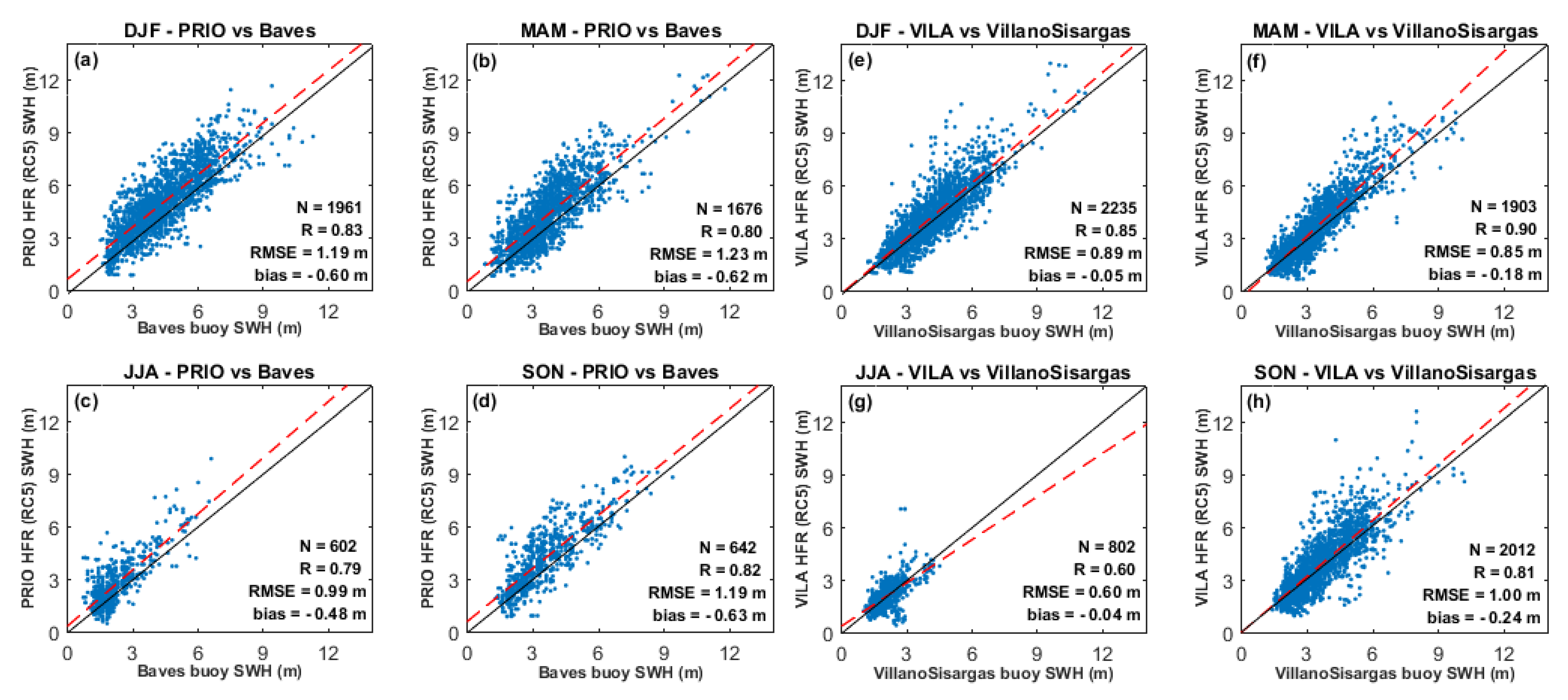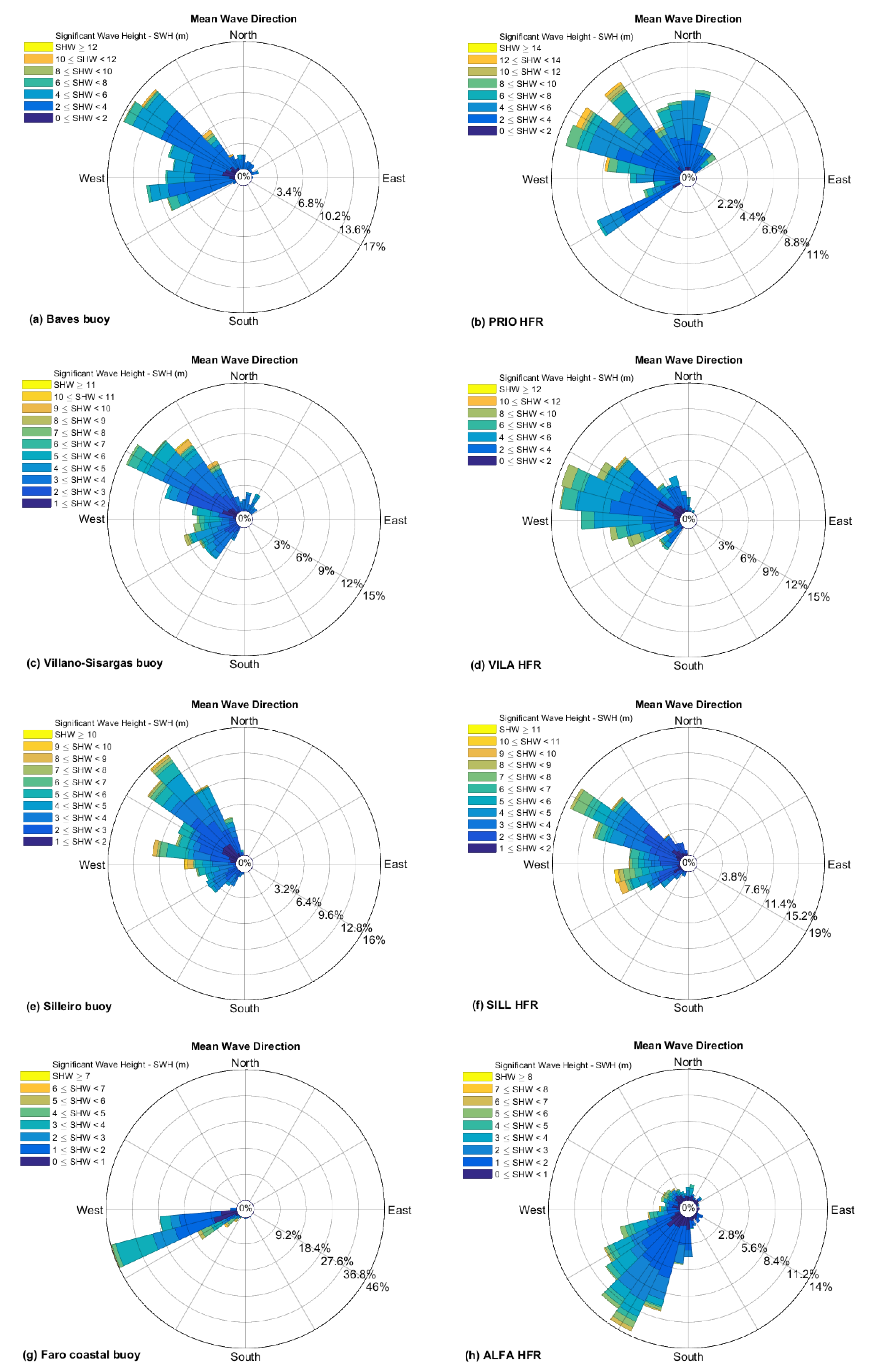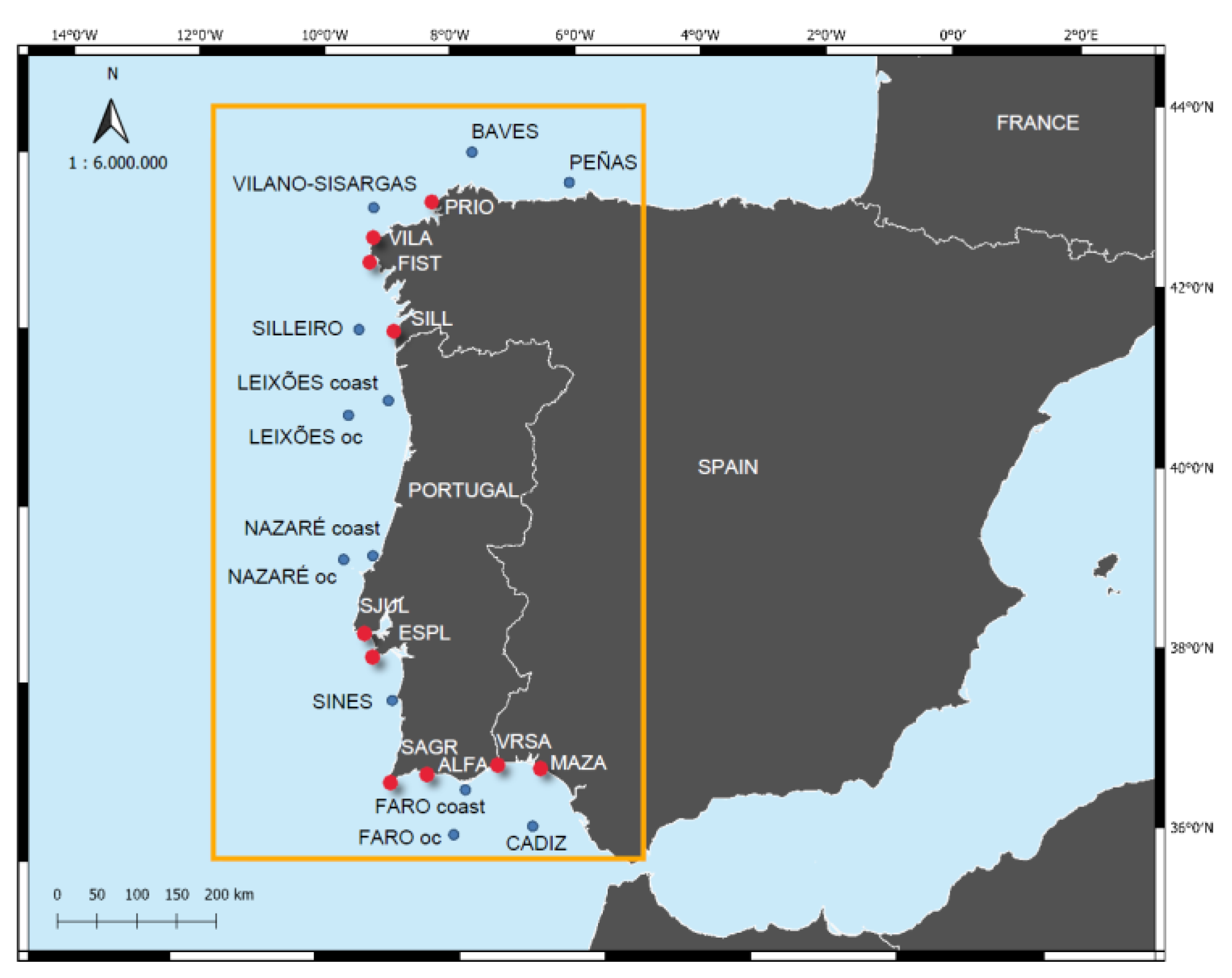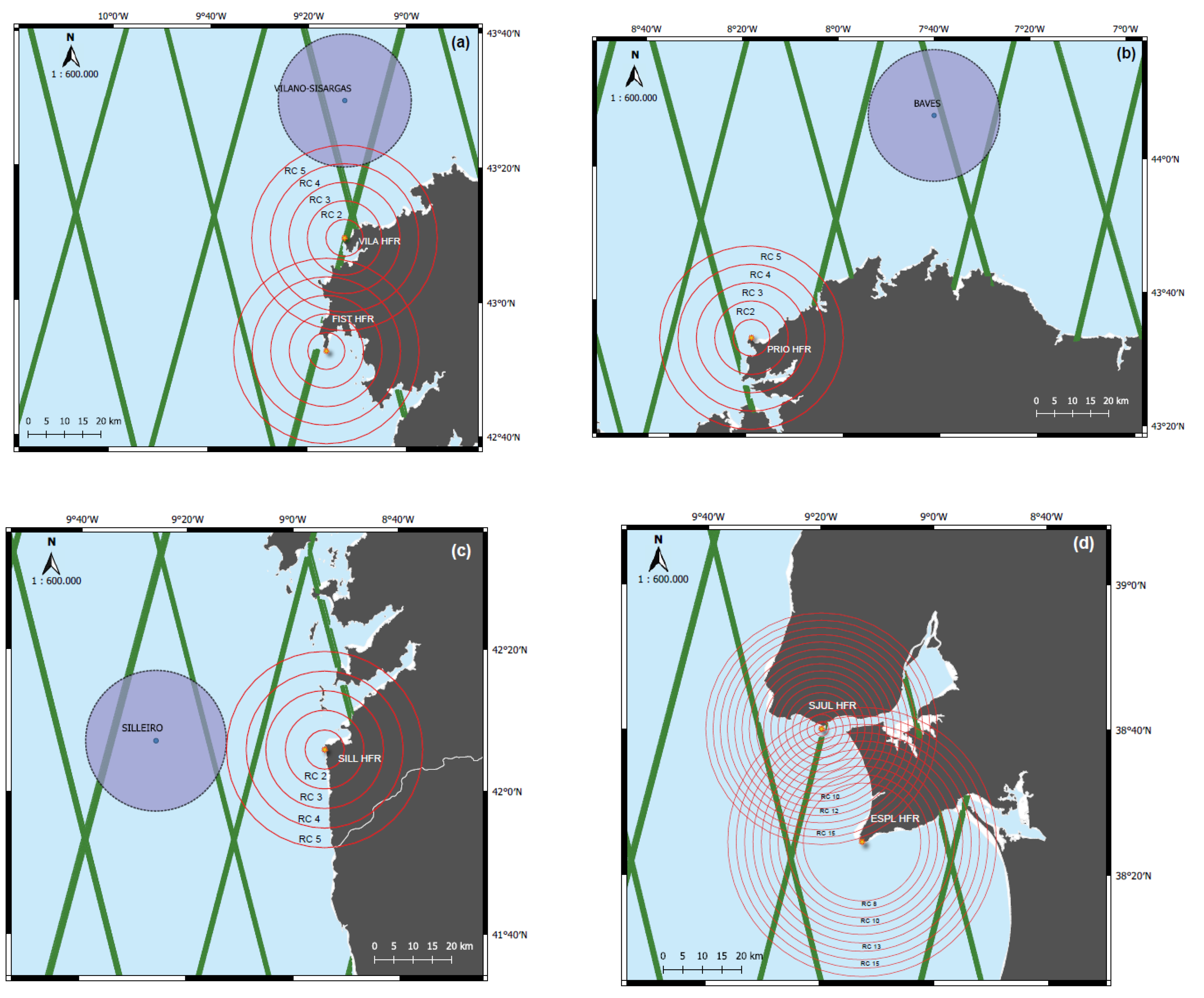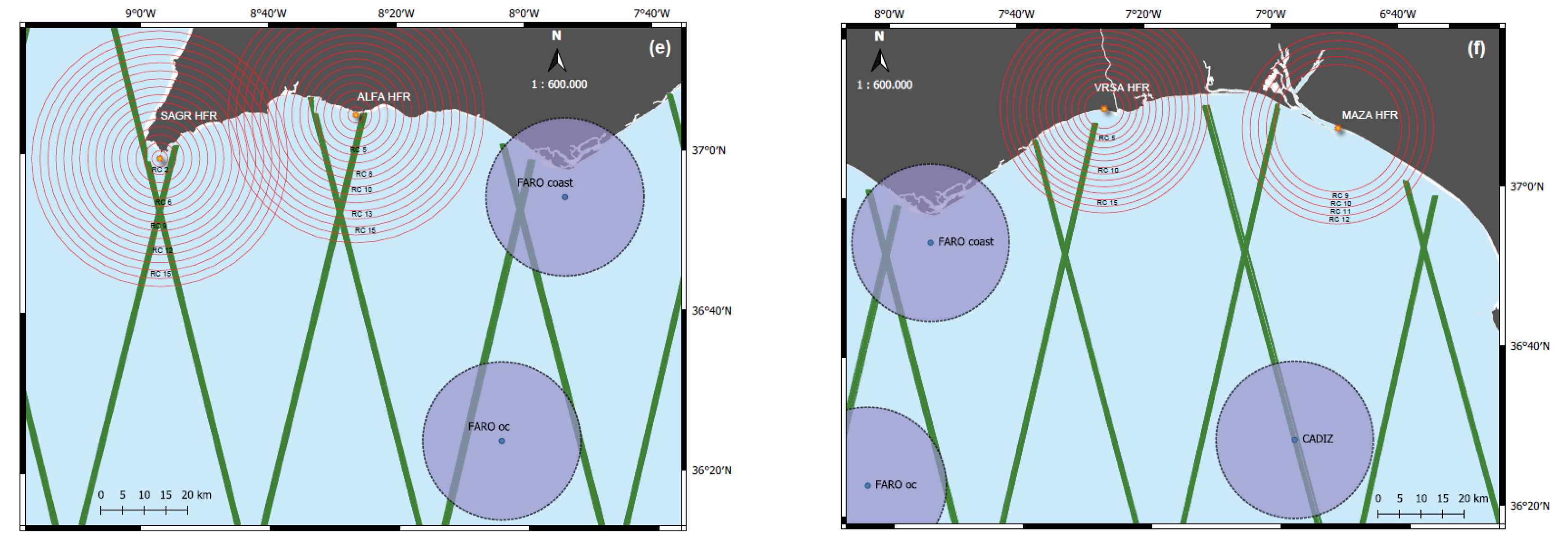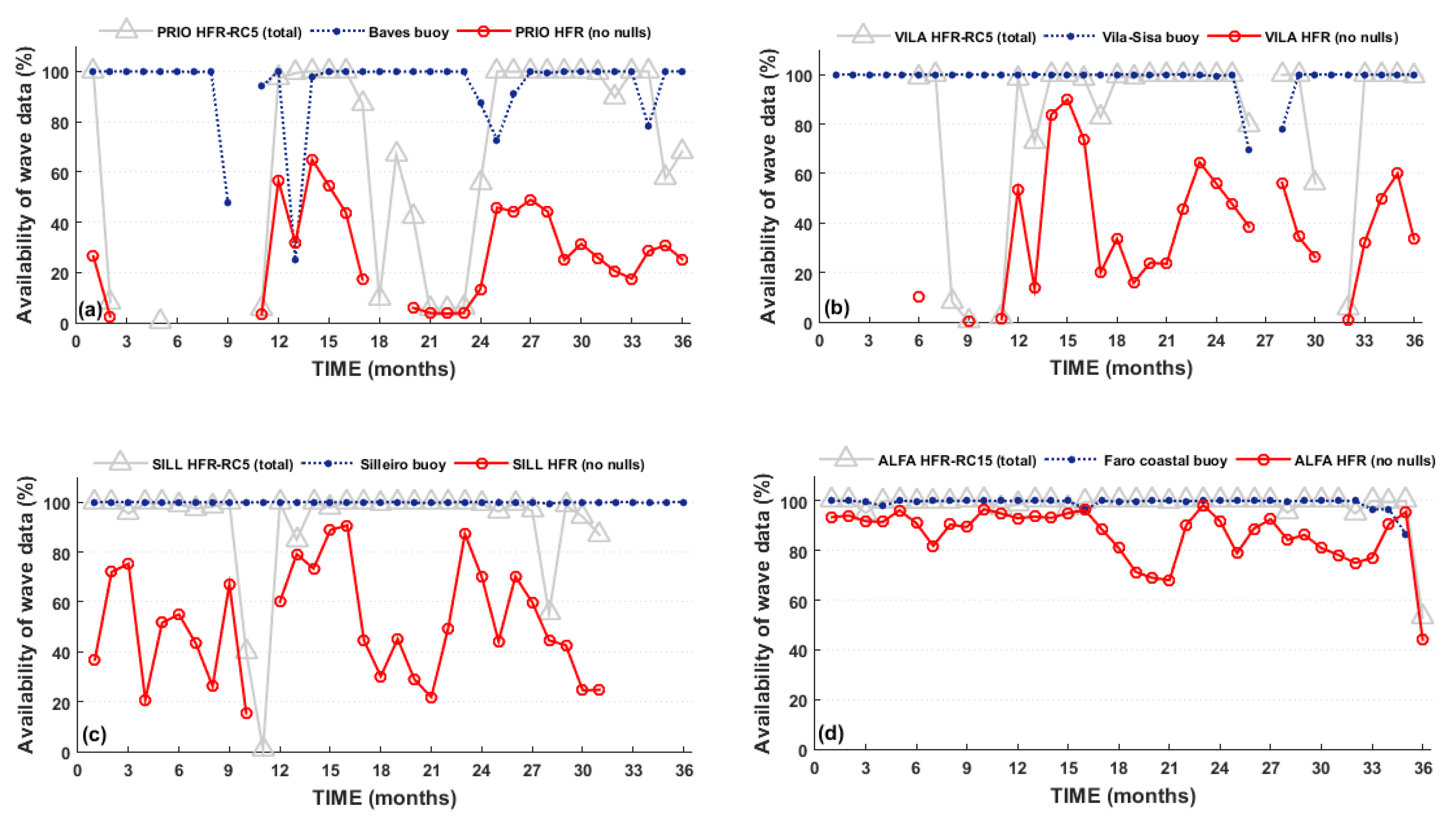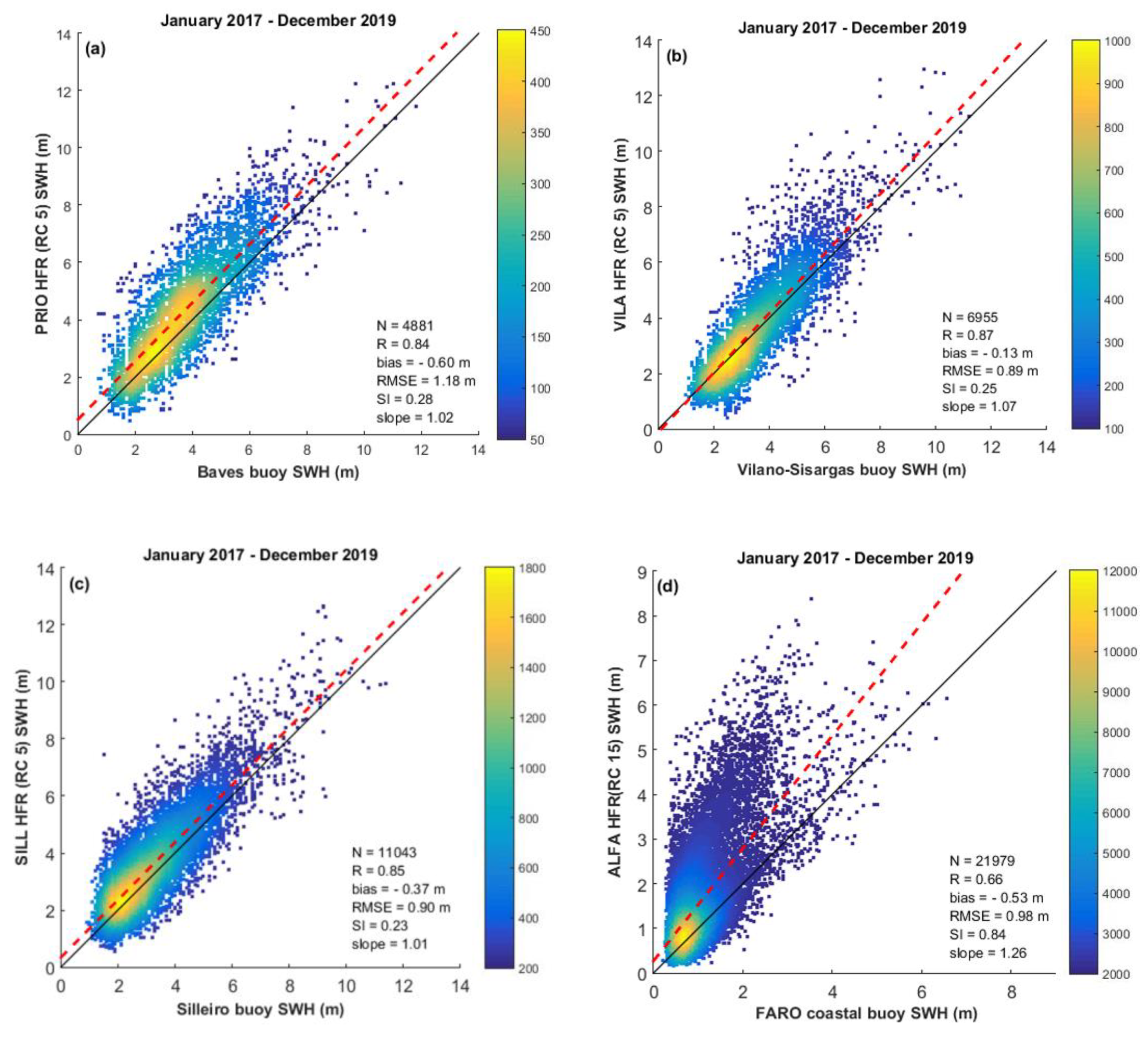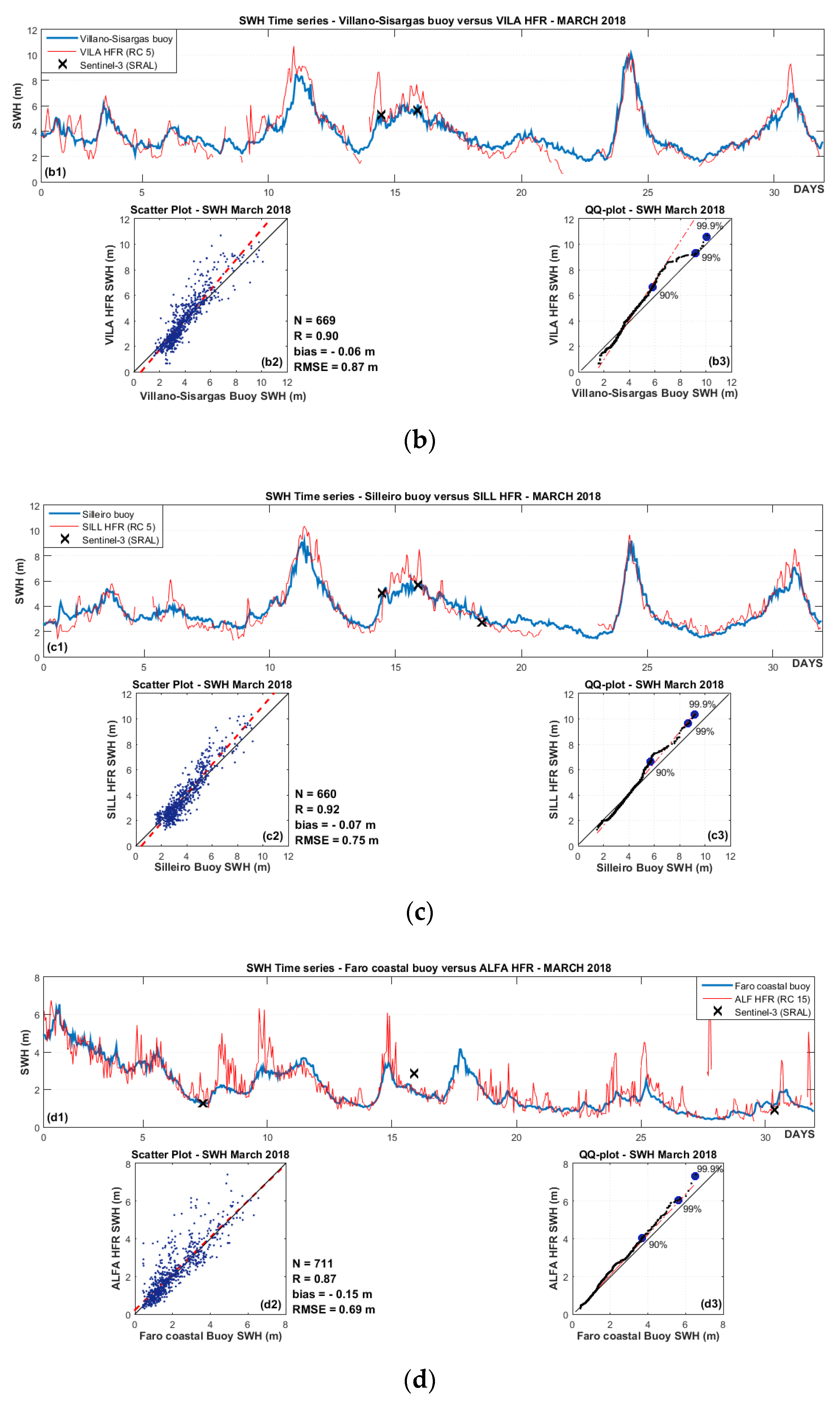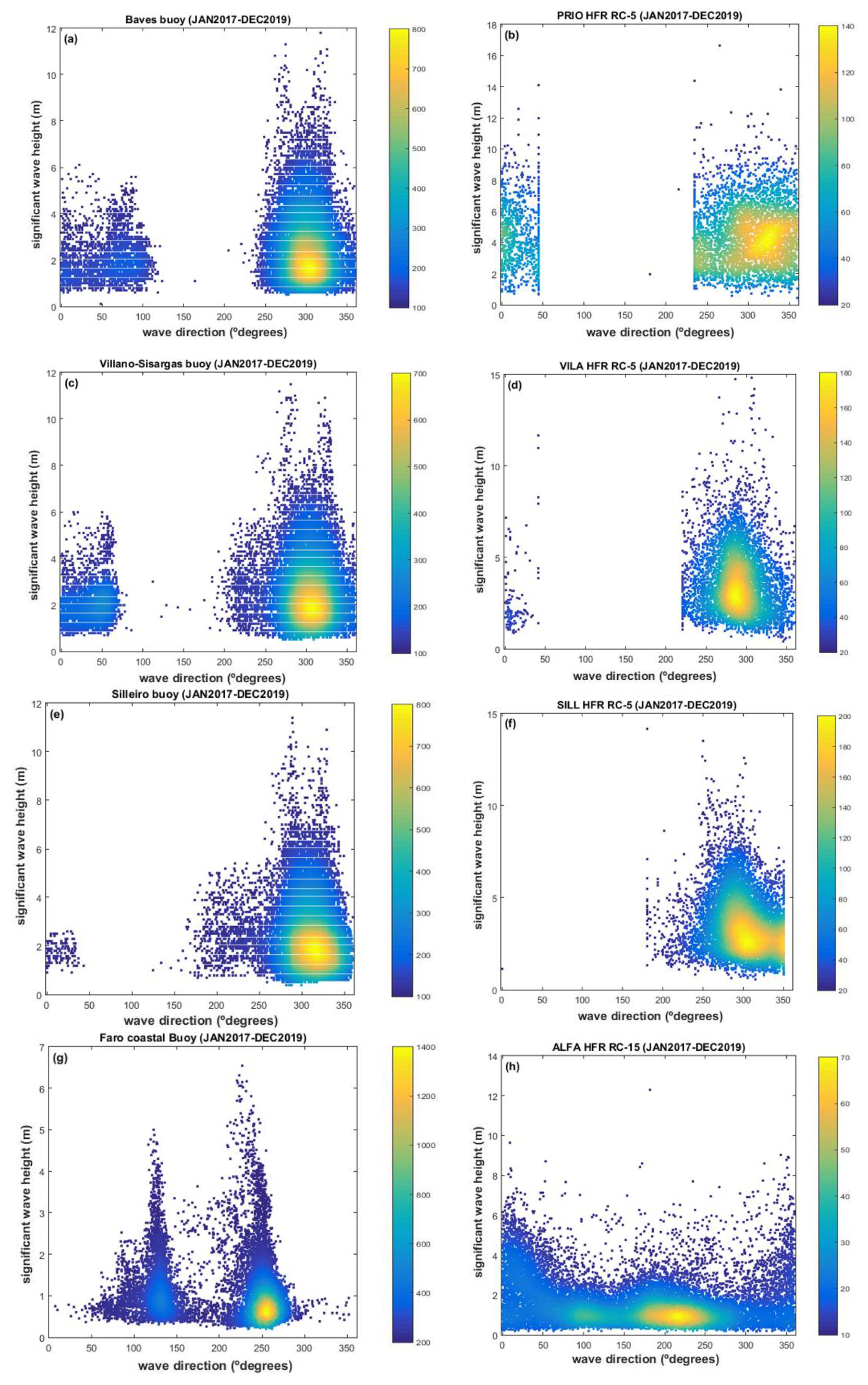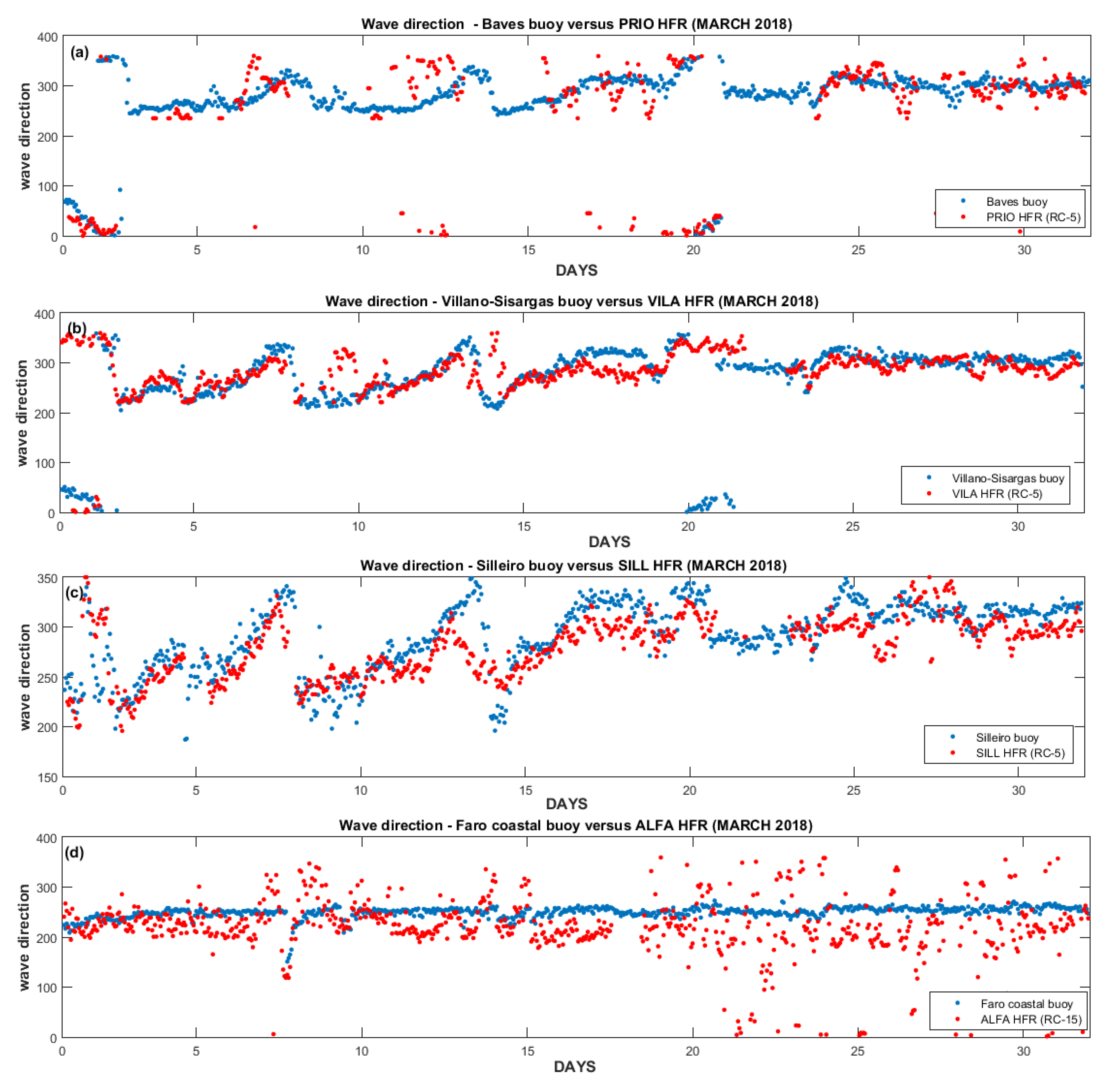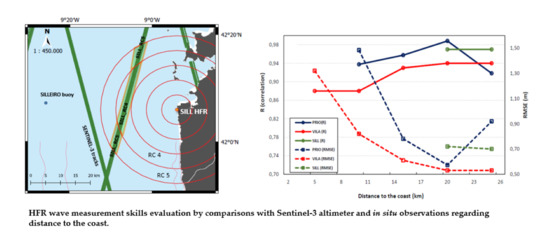1. Introduction
The Iberian Peninsula is characterized by contrasting meteorological and oceanographic conditions between different seasons, particularly at its western coast [
1,
2]. This region is strongly influenced by North Atlantic extratropical cyclones, especially during winter, and in summer by strong coast-parallel winds that drive coastal upwelling [
3,
4]. Bearing in mind that the Iberian Peninsula’s characteristic wave climate is one of the most energetic in Europe [
3,
5], constant observation and monitoring of the sea state and coastal dynamics is essential [
6]. In situ observations allow continuous monitoring of coastal areas and the production of reliable wave climate statistics [
7]. However, in situ wave measurements are disproportionally distributed, with most of them located in the northern hemisphere and near developed countries [
7,
8]. Remote sensing wave measurements, such as satellite altimeter (SA), are a good alternative to in situ systems, due to their global coverage [
3,
8,
9,
10].
Radar altimeters mounted onboard satellites, although primarily designed for ocean surface elevation monitoring, offer high-quality measurements of wind and wave height. For that matter, SA wave measurements have been essential since early the 1990s for wave model calibration, validation, data assimilation, as well as for wave climate studies [
11]. SA provides global coverage operating during day and night periods and through all-weather conditions [
11]. However, SA measurements can be less accurate near the coastline [
9,
11,
12], with the land contamination during the transition between land/water regions on SA tracks being the main reason [
8,
11,
12,
13]. Other factors can contribute to erroneous SA performances nearshore, such as the inaccurate removal of surface atmospheric effects or incorrect tidal corrections [
8,
9,
10,
12,
14]. Nevertheless, for open ocean or offshore areas, SA wave measurements are a good option to provide information about the sea state, mainly significant wave height (SWH). Earlier studies have shown that SA SWH measurements’ precision can be similar to wave buoy observations in the open ocean [
12,
13,
15,
16,
17]. Placing or maintaining in situ measuring instruments, like moored buoys, can be a challenging task in offshore areas. A good alternative for coastal and offshore in situ wave measurements are coastal High-Frequency Radars (HFR), that provide a close to permanent monitoring of the sea state [
18,
19,
20,
21,
22,
23,
24]. Nevertheless, the full coverage of the coast is not always possible. For that matter, a multidisciplinary method based on merging in situ and remote sensing observations from HFR and SA can represent a useful approach for interpreting the ocean’s sea state, arising as a promising strategy to improve the continuous monitoring of coastal areas [
9,
25]. However, it is worth mentioning the significant sampling differences between these sensors in coastal regions, both in time and space scales.
HFR systems in coastal areas typically measure ocean waves up to 30 km from the shore and simultaneously surface currents to more than 100 km [
18,
19,
20]. In Europe, the use of HFR coastal systems has been growing, with over 62 HFR sites currently operating [
26,
27]. HFR coastal systems have been identified as a cost-effective complement to in situ sensors, by increasing spatial coverage with lower maintenance costs. The range of HFR measurements is typically confined to coastal areas and can effectively fill other remote sensing monitoring systems’ measuring gaps, with considerably higher temporal resolutions [
21,
26]. HFR systems use the echo backscattered originated by the rough sea surface. Its relationship with surface wave phase speed was described initially by Crombie [
28]. Years later, the basic theory for measuring wave parameters using HFRs was developed by Barrick, which established the relation between the directional wave spectrum and the radar wave (Doppler) [
29,
30,
31]. Following these works, Stewart and Joy [
32] proposed using HFRs for monitoring currents in coastal areas. Nowadays, HFR are a well-accepted and reliable technology for current measurements, routinely used for oceanographic studies and operational services [
21,
27,
33]. The SeaSonde CODAR HFR system delivers robust ocean surface currents measurements, derived from the dominant first-order peaks in the radar echo spectrum [
18]. On the other hand, the wave parameters such as SWH, wave period, and wave direction are obtained from the spectrum’s second-order peaks, where the amplitude can be lower or weaker than the dominant first-order Bragg peaks [
3,
18,
21,
31]. These parameters can be obtained through integral inversion methods [
21] or by applying an oceanic wave spectrum model, such as Pierson-Moskowitz, to the second-order spectrum obtained by the radar [
18,
34]. The second-order spectrum, which has lower energy than the first-order one, is closer to the noise floor, and consequently, easily contaminated [
18]. In the presence of low-sea states (wave height < 2 m), the strength of the second-order spectra can be very weak, and spurious contributions to the spectrum would have a significant impact [
20,
35,
36]. Extreme wave events can also limit the HFR system’s ability to retrieve wave data, considering that the wave height increase can exceed the saturation limit imposed for the radar’s transmitting frequency. When the radar spectrum saturates, the extraction of wave spectra by the HFR can become close to impossible [
18,
25]. HFR wave parameters, like the SWH or wave periods, are secondary measurements that can be made by these systems and still an area of active research and understudy as well as the validation of some HFR wave products [
26,
33].
In the present study, we explore the robustness of wave measurements from SeaSonde CODAR HFR systems in the western Iberian Peninsula. The HFR performances are evaluated through a 36-month comparison of wave parameters with in situ (wave buoys), and SA measurements. The west coastal areas of the Iberian Peninsula have three HFR measuring sites in Galicia, two in the Lisbon area, and four more in the south (Algarve). The SWH comparisons between HFR, in situ, and SA measurements are achieved by considering buoy observations as ground truth. As the overlap between HFR and buoy observations is not available for every HFR site, SA SWH measurements are compared with wave observations extracted from individual HFR range cell (RC). The correlation between the HFR and SA collocated data allowed us to evaluate the HFR measurements’ availability and accuracy during the 36-month time window. The measuring skills of HFRs systems with the increasing distance from the coast is also assessed, as well as its ability to measure extreme wave heights events.
The present paper is organized as follows. The study area is described in
Section 2, along with the data sets, data analysis methodology, and a description of the validation metrics. The results over a 36-month observation period are shown in
Section 3, and the corresponding discussion is presented in
Section 4. Finally, the conclusions are summarized in
Section 5.
4. Discussion
The present study evaluates a 36-months long time series of HFR wave data. To our knowledge, only a few studies so far have considered time series of HFR wave data as long as the one presented here [
9,
34,
36,
37,
38,
46,
51,
52,
53,
54]. Even fewer studies have incorporated SA and HFR wave parameter comparisons in the same type of analysis [
3,
9,
33,
37]. In this study, an evaluation of SeaSonde CODAR HFR systems skills on retrieving wave data at the western Iberian Peninsula is carried out by comparing with
SRAL and in situ wave measurements.
Nowadays, HFR systems are a valid instrument for simultaneously measuring and monitoring surface currents and wave parameters [
20,
36,
50,
52]. The measurement of surface currents by HFR systems is, in fact, the main focus of most of the available literature [
32,
54,
55,
56,
57]. Nevertheless, HFR systems can also measure the wave spectrum and retrieve wave parameters [
18,
20,
27,
37]. As surface currents are obtained from the first-order Doppler spectrum of the radar, they can be measured over a broader range of sea states than waves. On the other hand, wave parameters are derived from the lower amplitude second-order radar echoes [
21]. The inversion of the second-order part of the backscatter spectrum and the validation of HFR wave parameter measurements are still active research areas [
23,
34,
35,
36].
Wave measurements from SA are good alternatives for monitoring coastal areas, due to their global coverage [
3,
8,
9]. However, SA tends to slightly overestimate the SWH compared with in situ observations, particularly in coastal areas [
8,
9,
10,
11,
12,
13]. While in open ocean SA data are of considerably good quality, the accuracy tends to deteriorate at nearshore areas, mainly due to land contamination in the altimeter footprint [
8,
9,
10,
11,
12,
13,
14,
15,
16,
17]. Theoretically, and regarding numerical models’ predictions in literature [
8,
9,
10,
11,
13,
15,
16,
17], SA accuracy is expected to decrease for observations progressively closer to the coast [
11,
12,
13,
15,
16,
17]. Thus, correlations with coastal buoy observations are characterized by an inverse relation with distance from the coast [
13]. Previous works argued that the correlation between SA and buoy measurements increases for distances further than 10 km from the coastline [
10,
12].
In this study, SRAL measurements from S3A and S3B are validated through buoy observations before being compared with HFR SWH data. Overall a good performance of SRAL measurements is noted through the West Iberian Peninsula coastal areas, with correlations for SWH measurements above 0.89, RMSE between 0.17 m to 0.42 m, and a regression slope range of 0.92–1.09. Even within 10 km off the coast, as in Faro and Nazaré buoys, the results revealed a higher agreement, with R varying between 0.95–0.98, biases from −0.05 m to 0.19 m, mean SI of 0.15, and RMSE between 0.19 m and 0.33 m, respectively. These results followed recent works that underlined the good performance of SRAL measurements beyond 5 km from the shore, after comparisons with buoy observations [
10,
13,
58,
59]. When comparing SRAL SWH data with U.S. National Data Buoy Center (NDBC) buoys, located between 5–25 km off the coast, results showed RMSE values of 0.30/0.31 m for S3A/S3B [
58]. Even when compared with similar SA sensors, such as Janson-2 or CryoSat-2, S3A had achieved better performances within 10 km of the coast (R = 0.91; bias = 0.17 m; SI = 0.33; RMSE = 0.40 m) [
8]. The SRAL performance over coastal areas and the ability to retrieve SWH beyond 5 km from the coast were demonstrated. Meanwhile, the first steps in using S3 SRAL to retrieve water surface elevation over rivers are being taken, with very satisfactory results over Chinese rivers (RMSE: 0.12 m to 0.9 m) [
59].
The co-location of radars and buoys for HFR wave data validation is ideal, but not always possible. In situ sensors give point observations, while CODAR SeaSonde HFR systems derive wave parameters from a least-squares fitting technique applied between second-order spectra and a Pierson-Moskowitz model. The homogeneity of the ocean spectrum is assumed over the HFR RC [
18,
19,
36,
37]. Direction-finding systems like CODAR SeaSonde HFR, require the validation of this assumption, while beam-forming systems, like WERA HFR, do not [
52]. It is certain that for HFR-buoy comparison, the inexistence of overlap between the buoy and HFR RC data sets was the motive that contributes the most for the relatively lower correlation of 0.66 in the ALFA site. The differences and the low correlations between HFR-buoy can partially be explained by assuming the spectrum homogeneity in the entire RC. This hypothesis can be erroneously assumed on the ground, due to relevant bathymetric variations in coastal areas [
34,
37].
Coastal effects can also lead to local variations in wave fields, making it even harder the HFR-buoy comparisons [
34]. Another possible explanation is because the CODAR SeaSonde software assumes infinite water depth [
34,
60,
61]. The shallow water effects can become significant for lower water depths, causing an impact on radar sea surface echo, increasing the second-order spectral energy, and decreasing the saturation limit on wave height as water depth decreases [
61]. For a radar transmit frequency of 5 MHz, the depth at which shallow water creates an effect is 35 m [
34]. Other studies revealed that for 13 MHz transmitting frequency radar, shallow water effects become significant in water depths <30 m [
60]. Due to the Iberian coastline morphology and its associated bathymetry, all the buoys are positioned in depths >50 m. All the RCs selected to be compared with in situ observations are the RCs furthermost from the HFR origin. These RCs are located at 25.5 km (Galician sites) and 27.75 km (ALFA site) from the shoreline, at depths >50 m, far enough to ensure the deep-water assumption.
Despite these limitations, HFR and buoy observations appear to capture similar wave features and temporal variability. For HFR-buoy SWH comparison, a general overestimation of the SWH by the HFR has been noted. All the results revealed negative bias values. The correlation and the RMSE of the observation pairs overall (36-months) had reached to 0.66–0.87 and 0.89–1.18 m, respectively. Concerning individual monthly evaluations, higher correlations are achieved, such as December 2017 (PRIO), January 2019 (VILA), and March 2018 (SILL and ALFA) (see
Table A1,
Table A2 and
Table A3 in
Appendix A). This fact is related to the availability of HFR wave data through different seasons and sea states. Even so, the ALFA HFR presented the less accurate results and a higher overestimation of SWH, easily noted through the spreading of the observation pairs in the scatter plots (
Figure 7d), revealing a SI of 0.84. To evaluate if the previous statistic metrics present some seasonality, the datasets were divided into four seasons (DJF/MAM/JJA/SON). JJA in all the 4 HFR-buoy sensor pairs is the period with lower HFR valid observations and lower/higher R/slope values, contrasting with stormy weather periods. These results are aligned with previous studies [
36,
49] were the best comparative results are obtained in the winter when the wave field is more energetic, and the limitations, due to low sea-states are rare. The lowest amount of valid observations is also obtained in the summer periods (
Figure A1c,g,
Figure A2c,g). In fact, the agreement between the datasets is better when the SWH > 2 m. The seasonal analysis allows achieving that the best agreements are in the DJF and MAM periods. However, the MAM period results were inflated by the statistics already presented for March’s months (
Table A1,
Table A2 and
Table A3). The lowest values for R (0.46–0.60) were achieved in the JJA period (
Figure A1c,g,
Figure A2c,g), contrasting with the 0.74–0.90, obtained in the winter periods (
Figure A1a,e,f,
Figure A2a,e). In the JJA period, particularly for the ALFA vs. Faro coastal buoy comparison, the buoy SWH during the entire period did not exceed 2 m (
Figure A2g). The presence of SWH <2 m contributes to the worse statistic results achieved for JJA, due to the weakened second-order spectra, which can impact the wave parameters extraction, with spurious contributions to the spectrum [
20,
35,
36]. This fact can lead to SWH overestimation by the HFR system in sheltered areas like Algarve, characterized by low sea states.
The lower R results achieved through the HFR-buoy comparison can also be explained, due to no overlap between HFR-buoy wave data sets. Faro coastal buoy is moored 22 km apart from the ALFA RC15, the furthermost RC with wave data. On the other hand, the ALFA site is in an area where low sea states are frequent (wave height < 2 m). In low sea state areas, the strength of the second-order spectra can be fragile. Simultaneously, spurious contributions to the spectrum would have a more relevant impact, leading to wave height overestimation [
7,
23,
46]. In the literature, previous reports present similar results. At the southern coast of the UK, 12 MHz phased array HFRs, during an evaluation of five months, SWH analysis reveals nearly zero bias, R above 0.90, RMSE between 0.29–0.44 m and SI = 0.2 [
35]. A 25 MHz, CODAR HFR system had presented R = 0.75 and RMSE above 0.20 m, for a 2010 wave data set in the Gulf of Naples [
36]. In Galway Bay, three months of SWH comparisons between CODAR HFR-buoys also showed a good agreement, with an RMSE of 0.34 m and an R = 0.78 [
51]. In the Galway Bay area and over a more extended period (27 months), another study presents an R of 0.78–0.86 and an RMSE between 0.18 m and 0.29 m [
49]. For the central California coast, a 12–13 MHz set of five CODAR SeaSonde HFR sites have achieved an R between 0.85–0.91, with an RMSE = 0.53 m in a 15–26-month period study [
37].
For the Galicia NW area, several studies had been conducted, evaluating the same HFR sites as in our research [
3,
34,
50]. These previous studies revealed good agreement, regardless of the different time windows chosen for each one. SILL and FIST HFR, after site installation in 2005, had presented correlations of 0.89–0.94 and 0.68–0.89 m for RMSE, when compared with wave buoys, during a representative 3-months period (November 2005–February 2006) [
50]. The 1–3-month study, which had analyzed the impact of the Ophelia storm (October 2017) at the NW of Galicia, presented R > 0.85 and RMSE between 1.03 m and 1.09 m, through the SWH comparison between VILA/SILL HFR with Vilano/Silleiro buoys [
3]. The more extended analysis conducted in the same area, for a time window of 27 months, presents R above 0.75 and normalized RMSE values under 0.4, through the SWH comparison from the same sensors [
34].
Wave period and wave direction are parameters considerably more sensitive to the radar backscatter noise, particularly in low sea states [
20,
36]. Tc from HFR includes all contributions from swells and wind sea to the second-order spectrum [
20]. On the other hand, buoys may measure swell periods from wind sea in a separately way [
37]. Wave period comparison results are in agreement with other SeaSonde HFR-buoy wave periods’ comparison studies. The HFR Tc had fallen between the buoy’s Tm and Tc. The buoy Tp had present better agreement with Tc, with correlations between 0.52 to 0.65, RMSE of 1.90–3.09 s, and a slight underestimation of the Tc by the HFR (
Figure A3 and
Table 3). Long et al. [
37] has presented similar results, yielding correlations of 0.61 and 0.74 for dominant and average periods, and associated RMS differences of 2.86 s and 3.39 s. Other longer duration HFR wave data studies compared Tc with Tp and Tm, validating that the HFR wave period takes values between the other two [
36,
37].
Regarding the wave direction analysis, the scattered in the time series plots during low sea states (SWH < 2 m) proved that the wave height strongly influences this parameter. The fact that HFR systems can only detect wave propagation in the radial directions, moving away or towards the HFR site, might contribute to the directional uncertainties [
34]. Previous studies have revealed the CODAR SeaSonde HFR system predisposition for retrieving wave directions aligned more perpendicular to the coast [
62]. The wave rose plots in
Appendix A (
Figure A4) confirm this hypothesis. In Galicia coastal areas, for PRIO and VILA HFR sites, the related depth contours present NNE-SSW orientation. In
Figure A4b,d, the direction of incoming waves is from WNW sectors, perpendicular to the depth contour in these coastal areas. The same is showed for SILL HFR, where the related depth contours present an N-S orientation. In
Figure A4f, the direction of the incoming waves is from the westernmost sectors. Even for the ALFA HFR site, located in Algarve, the coastal areas’ depth contours have a W-E orientation. The ALFA HFR site presented an SSW wave direction, more perpendicular towards the coast than in situ observations (
Figure A4g,h). Similar results are described by Lorente [
34] for the Galician HFR sites.
The HFR evaluation in detecting extreme wave events shows that the PRIO, VILA, SILL, and ALFA sites can recognize variations and higher wave events. All the analyzed HFR are more stable, facing higher sea states, and presented a higher availability of wave data. During Emma’s storm, HFR showed the same wave pattern (time and space), comparatively with buoys. The achieved results are following previous works [
3,
33,
34,
51]. The higher number of radar nulls and spurious values affected the statistic metrics, and consequently, the use of the HFR system to conduct operational monitoring of coastal areas. Other studies [
23] have excluded more than 50% of the wave information during a statistical analysis of the wave parameters estimated by the HFR in NW of Spain (16 months’ study).
Figure A1c,g,
Figure A2c,g shows that the number of spurious values can be related to seasonality (JJA—summer periods), and consequently, with lower sea states (SWH < 2 m).
Considering the time and space resolutions differences between HFR and SA, the HFR SWH was compared with SRAL measurements. Coastal applications tend to benefit from higher resolution and the improved temporal sampling provided by HFR. The same is not the truth for other remote sensing sensors, like the SRAL. However, the temporal resolution for SA in the open ocean is an acceptable solution for operational ocean applications, like assimilation in wave or circulation models. Due to the low overlapped wave data from HFR-buoy, SRAL measurements were compared with individual RC. SA low accuracy in coastal areas cannot be neglected, considering that the comparison results can be affected. Even so, the initial validation of the SRAL SWH with buoys have revealed high agreement within 10 km from the shoreline. The closest buoys are Nazaré coastal, Sines, and Faro coastal distanced 7.42 km, 5 km, and 6.63 km from the coast, respectively. The buoy-SRAL SWH comparison revealed correlations of 0.98, 0.91, and 0.95 for these buoys, and associated RMSE was 0.33 m, 0.65 m, and 0.19 m, respectively.
Given these results, individual RC SWH measurements were compared with its SRAL SWH pair. The correlation between the two remote sensed data sets shows a good agreement, particularly for RC4 of the Galicia HFR sites (20.4 km from the coast). The analysis reveals the R between 0.94–0.99 and RMSE from 0.53 to 0.81 m. These results agree with previous works in the literature [
3,
9,
33]. The analysis conducted in the Malta-Sicily Channel, which compared 4 CODAR HFR with SA, achieved R between 0.77–0.94 and revealed an RMSE of 0.26 m to 0. 85 m [
28]. For the remaining HFR sites, the results were less promising. ALFA HFR shows R = 0.82 and RMSE = 0.68 m for RC11 (20.35 km), and R = 0.77 and RMSE = 0.61 m for RC13 (24 km). A constant negative bias through all the HFR RC indicates the overestimation of the SWH by the HFR. The statistic results (R, RMSE and best RC) for the other HFR sites were: 0.70, 0.72 m and RC6 (11.1 km) for SJUL; 0.84, 0.74 m and RC10 (21.5 km) for ESPL; 0.53, 1.24 m and RC10 (18.5 km) for SAGR and 0.46, 1.26 m and RC12 (20 km) for MAZA (see
Appendix A—
Table A4,
Table A5 and
Table A6). The validation of the HFR SWH by SRAL measurements had also revealed that HFR accuracy varies with distance from the coast. Errors are lower in the intermediate RC. The correlation between data sets is better, neither too far nor too close from the HFR antenna origin [
12,
33,
51].
The differences between the 4.86 MHz and the 12–13.5 MHz HFR performances need a deeper investigation. The HFR operating frequency determines the wave height (maximum and minimum threshold) captured by the CODAR SeaSonde system. The lower the frequency, the higher the sea states recorded by the HFR [
20,
26,
36]. Below the lower threshold, and for lower sea states, the second-order echoes are closer to the noise floor. Therefore, data acquisition is more susceptible to contamination, leading to spurious estimations and limitations on wave measurements [
18,
19,
20,
23,
52]. The lower frequency radars do not have radar spectral saturation problems or, with the second-order spectrum, be covered close to the first-order region [
18]. However, the radar’s frequency needs to be sufficiently high for the second-order echoes emerging from the noise floor. On the other hand, the 12–13.5 MHz radar saturates when the wave height exceeds the limit defined by transmitting frequency, meaning that high waves information is not provided [
18,
19]. For the Iberian HFR sites, the ideal for wave measurements is a low-power HFR instrument capable of switching transmit frequency from 5 to 13 MHz, as the wave height approaches the saturation limit [
18]. Operating in the higher frequency, we would have wave data for low and moderate sea states. If the wave height increases toward the higher frequency saturation limit, the transmit frequency switch to 5 MHz, allowing to measure higher wave heights [
18].
5. Conclusions
Efforts in monitoring shoreline and coastal zones have proved to be of utmost importance in the last years, either for the early detection of extreme phenomena such as severe storms or tsunamis, as well as flood mitigation or coastal areas management. Effective coastal monitoring can be done by buoys or remote sensing sensors, such as SA or HFR. The combination of these sensors data can provide a comprehensive characterization of the wave conditions in coastal areas. HFR systems are now a well-accepted technology for currents measurements. Wave parameters, such as the SWH, wave period, and wave direction, can also be extracted from the HFR systems. However, wave parameters are extracted from the spectrum’s second-order echoes, which are weaker and noisier than first-order ones, posing some limitations for wave applications. Comparatively, with offshore buoys, proximity to the HFR sites and its lower maintenance costs ensures continuous data return, apart from wave data availability. In this study, a 36-month (2017–2019) evaluation of HFR skills on retrieving wave data in the western Iberian Peninsula was validated through comparisons with satellite altimeter and in situ observations.
The validation of the HFR SWH data with buoy observations showed correlation coefficients of the order of 0.66–0.87 and an RMSE between 0.89 m to 1.18 m. The validation with co-located SRAL measurements over the HFR range cells (RC) showed significant differences in the 4.86 MHz and 12-13.5 MHz HFR performances. The lower frequency HFR (PRIO, VILA, and SILL) presented correlations between 0.86 to 0.99 and RMSE above 0.53 m. The higher frequency HFR (SJUL, ESPL, SAGR, ALFA, VRSA, and MAZA) revealed correlations under 0.82 and RMSE above 0.61 m. The analysis of both higher and lower frequency HFR showed negative bias, which indicates overestimation by the HFR, as in the HFR-buoy comparisons.
The differences between higher/lower HFR frequencies results should be further investigated. However, the observed discrepancies and the overestimation of the SWH can be mainly connected to lower sea states (<2 m), mostly in the south area HFR sites, causing spurious contributions in the directional spectrum and contaminating wave measurements. The low availability of wave data in some of the HFR has also contributed to its lower performance. The CODAR SeaSonde system assumed homogeneity over the wave parameters through each RC, can partially explain the differences found. The distance from each RC to the HFR origin, or the differences in the sea state along and through each RC, may lead to different wave data availability among HFR RC. The mitigation of the discrepancies mentioned before can be carried out with new updates for the system software. These updates must consider improvements in the inversion method assumed for wave data extraction. A dual-frequency transmitting antenna, with the possibility of frequency switching according to the sea states, is also a good improvement.
The HFR’s ability to detect wave height extreme events was also evaluated during the Emma storm passage over the Iberian Peninsula (from 28 February to 2 March 2018). The PRIO, VILA, SILL, and ALFA HFR sites had captured correctly, in time and space, wave height values. In the ALFA and in the Galician HFR sites, SWH of 6 m and 8 m were captured. The presented results show the potential of these HFR sites to capture extreme wave events.
Overall, HFR showed to have the potential for wave data retrieving. With the appropriate adaptations and improvements, this set of HFR can be used for marine safety, tsunami warning, hazard detection, Search and Rescue operations, or coastal zone management. S3 SRAL SWH measurements show a good performance near the coast. However, HFR measurements present a better temporal and spatial resolution, covering larger and closest to shoreline areas. These two remote sensing techniques, with the necessary adjustments, can fill the gaps of in situ sensors, acting in a complementary way for coastal areas monitoring.
